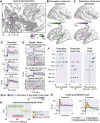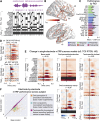Spatiotemporal Mapping of Auditory Onsets during Speech Production
- PMID: 39455254
- PMCID: PMC11580786
- DOI: 10.1523/JNEUROSCI.1109-24.2024
Spatiotemporal Mapping of Auditory Onsets during Speech Production
Abstract
The human auditory cortex is organized according to the timing and spectral characteristics of speech sounds during speech perception. During listening, the posterior superior temporal gyrus is organized according to onset responses, which segment acoustic boundaries in speech, and sustained responses, which further process phonological content. When we speak, the auditory system is actively processing the sound of our own voice to detect and correct speech errors in real time. This manifests in neural recordings as suppression of auditory responses during speech production compared with perception, but whether this differentially affects the onset and sustained temporal profiles is not known. Here, we investigated this question using intracranial EEG recorded from seventeen pediatric, adolescent, and adult patients with medication-resistant epilepsy while they performed a reading/listening task. We identified onset and sustained responses to speech in the bilateral auditory cortex and observed a selective suppression of onset responses during speech production. We conclude that onset responses provide a temporal landmark during speech perception that is redundant with forward prediction during speech production and are therefore suppressed. Phonological feature tuning in these "onset suppression" electrodes remained stable between perception and production. Notably, auditory onset responses and phonological feature tuning were present in the posterior insula during both speech perception and production, suggesting an anatomically and functionally separate auditory processing zone that we believe to be involved in multisensory integration during speech perception and feedback control.
Keywords: auditory perception; intracranial electrophysiology; language; speech; speech motor control; speech production.
Copyright © 2024 the authors.
Figures







Update of
-
Processing of auditory feedback in perisylvian and insular cortex.bioRxiv [Preprint]. 2024 May 14:2024.05.14.593257. doi: 10.1101/2024.05.14.593257. bioRxiv. 2024. Update in: J Neurosci. 2024 Nov 20;44(47):e1109242024. doi: 10.1523/JNEUROSCI.1109-24.2024. PMID: 38798574 Free PMC article. Updated. Preprint.
References
-
- Appelbaum I (1996) The lack of invariance problem and the goal of speech perception. Proceeding of Fourth International Conference on Spoken Language Processing. ICSLP ‘96, 3, 1541–1544 vol.3. 10.1109/ICSLP.1996.607912 - DOI
MeSH terms
Grants and funding
LinkOut - more resources
Full Text Sources
